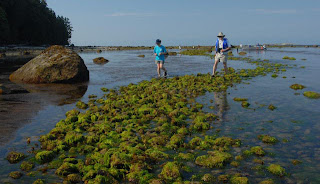‘Using the rhythm of nature to feed our people’
“Dr Dana Lepofsky, one of the SFU project directors, said that the work so far “gives us a huge amount of respect and awe for the technologies and people of the past… “There was clearly a large population living off the land and sea in a sustained way,” Lepofsky said. “Sometimes resources were hit, but it was clearly a sustainable economy.
“People were harvesting with local observations and had a vested interest.
They knew that if you over-harvest, then there is not going to be food for next year. “We see things like people choosing among different resources. If they got a lot of a resource early in the season, they might take less of another one. They would do this ‘dance to the season’.
http://www.sliammonfirstnation.com/archaeology/huntersandgatherers.pdf
What are Clam Gardens?
"A “clam garden” or “wuwuthim” in Tla’amin language, is a natural clam beach that has been cleared of rocks and terraced with a rock wall to increase clam production. The wall acts as a barrier for sand to build up against,to create a longer flat area of shallow water...These rock walls could be anywhere in size from 0.5 to 2 metres tall, and span many kilometres along the shoreline. By extending the beach flat seaward and clearing the beach of large cobbles, clam gardens create more suitable habitat or living space for clams."
http://www.sliammonfirstnation.com/archaeology/clams2.html
"Although never “lost” to First Nations knowledge keepers, clam gardens have only been relatively recently “discovered” by non-native Northwest Coast scholars who viewed them as either natural rock structures, or structures for another purpose. Dr. John Harper, a geologist, and Judith Williams, an artist, began separate investigations into these rock structures in the early 1990s, but it was not until each of them met with First Nations elders, knowledge keepers, and other long time coastal residents, that the academic’s mystery about these structures was “solved.”"
http://www.sliammonfirstnation.com/archaeology/clams4.html
Fish Traps
"Many peoples living on the Northwest Coast, including the Tla’amin, built large structures out of wood or stone in the intertidal zone and at the mouths of rivers to catch fish. These structures are commonly known as fish traps, and their remains can be seen in many places throughout Tla’amin traditional territory..."
http://www.sliammonfirstnation.com/archaeology/fishtrap.html
(Author's name not given)
“Dr Dana Lepofsky, one of the SFU project directors, said that the work so far “gives us a huge amount of respect and awe for the technologies and people of the past… “There was clearly a large population living off the land and sea in a sustained way,” Lepofsky said. “Sometimes resources were hit, but it was clearly a sustainable economy.
“People were harvesting with local observations and had a vested interest.
They knew that if you over-harvest, then there is not going to be food for next year. “We see things like people choosing among different resources. If they got a lot of a resource early in the season, they might take less of another one. They would do this ‘dance to the season’.
…the stone alignments that exist in the inter-tidal zones along the coast were not necessarily use for just one resource or just one purpose. Lepofsky said that phrases like ‘fish traps’ and ‘clam gardens’ are something of a misnomer. They could have been holding ponds for fish stock, traps for harvesting or places to cultivate and manage shellfish. They often were used for many purposes and not necessarily just one resource. It’s a pretty powerful story about long-term use that by definition was sustainable.”
http://www.sliammonfirstnation.com/archaeology/huntersandgatherers.pdf
What are Clam Gardens?
"A “clam garden” or “wuwuthim” in Tla’amin language, is a natural clam beach that has been cleared of rocks and terraced with a rock wall to increase clam production. The wall acts as a barrier for sand to build up against,to create a longer flat area of shallow water...These rock walls could be anywhere in size from 0.5 to 2 metres tall, and span many kilometres along the shoreline. By extending the beach flat seaward and clearing the beach of large cobbles, clam gardens create more suitable habitat or living space for clams."
http://www.sliammonfirstnation.com/archaeology/clams2.html
"Although never “lost” to First Nations knowledge keepers, clam gardens have only been relatively recently “discovered” by non-native Northwest Coast scholars who viewed them as either natural rock structures, or structures for another purpose. Dr. John Harper, a geologist, and Judith Williams, an artist, began separate investigations into these rock structures in the early 1990s, but it was not until each of them met with First Nations elders, knowledge keepers, and other long time coastal residents, that the academic’s mystery about these structures was “solved.”"
http://www.sliammonfirstnation.com/archaeology/clams4.html
Fish Traps
(One of many images of Stone Fish Traps to be found at the link below)
http://www.sliammonfirstnation.com/archaeology/fishtrap.html


No comments:
Post a Comment